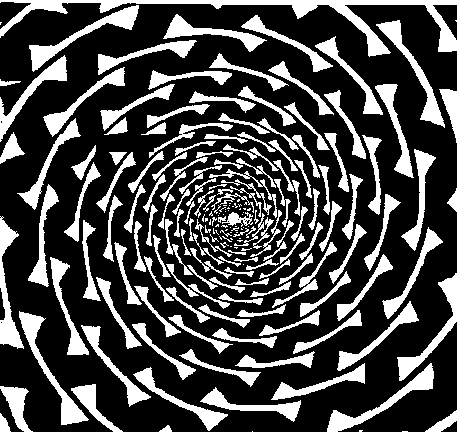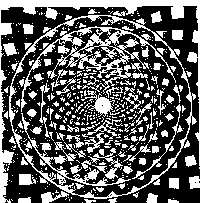This image was first published by James Fraser to illustrate certain matters relating to perception that were later developed by gestalt psychology. I am using it for a different purpose relating to the social processes that lead to a person encountering the image and "perceiving" it.
 |
Fraser drew this image to produce a perception of lines circling into a center when the image, when analyzed rationally is a representation of concentric twisted black and white ropes (you may be able to perceive these by hiding two-thirds of the image). He must have started with a white page and, carefully, drawn a series of black figures.
 Eighty years later, I scanned the
image from an old journal and produced something like the image on the left.
The resulting image was full of "noise" produced by smudges on the pages of
the journal and limitations in the scanning software. In order to reconstruct
the image, I edited it, pixel by pixel. Your current encounter with the image
is thus the result of two social processes (at least) that produced it over
time.
Eighty years later, I scanned the
image from an old journal and produced something like the image on the left.
The resulting image was full of "noise" produced by smudges on the pages of
the journal and limitations in the scanning software. In order to reconstruct
the image, I edited it, pixel by pixel. Your current encounter with the image
is thus the result of two social processes (at least) that produced it over
time.
It would be misleading however to argue that an encounter with the image is an encounter with the social processes. These are interesting but the power of the image over the brain does not have much to do with the social processes. We could say that the social processes used, coopted, manipulated some knowledge about the brain in order to produce an experience.
The same argumentation underlies the argument McDermott and I make in Successful Failure (1998) that a cultural pattern like "School" can produce overwhelming real events such as a "failing child" (in the same way as the first figure produces an overwhelmingly real impression of a ellipsis) and that understanding the properties of this pattern does not require either a study of the historical processes that produced American schooling or a focus on the child as apparent carrier to the failure.